Along the banks of the Delaware River—in what is now Upper Makefield Township on the Pennsylvania side and Hopewell Township on the New Jersey side—lie a pair of preternaturally venerated sites, indelibly linked by their shared connection to one of the most notable military enterprises the world has ever known. That would be the legendary water-borne crossing by Gen. George Washington’s troops on Christmas night 1776—a traversal fraught with difficulty by “the force of the current, the sharpness of the frost, the darkness of the night, the ice which [formed] during the operation, and a high wind,” as described by one Continental officer, Maj. James Wilkinson.[1] Prior to this undertaking, the Rhode Island Quaker turned warrior, Maj. Gen. Nathanael Greene, had mused, “I hope this is the dark part of the night, which generally is just before day.”[2] The metaphorical dawn that ensued from the “Ten Crucial Days” campaign (December 25, 1776 through January 3, 1777) reversed the momentum of the war for independence just when it appeared the insurgent army—and with it perhaps the cause it embodied—was on the verge of collapse.
In the immediate aftermath of that endeavor and the ensuing victory over the German brigade occupying Trenton, Ambrose Serle, private secretary to Adm. Richard Lord Howe, expressed his concern that “it will tend to revive the drooping spirits of the rebels and increase their force,” and regretted that “it will detain me probably for a further space of time from my longed-for home, and the happy enjoyment of my family and friends.”[3] Indeed. Reflecting on this turn of events from a more distant vantage point, the English historian Sir George Otto Trevelyan famously opined, “It may be doubted whether so small a number of men ever employed so short a period of time with greater and more lasting effects upon the history of the world.”[4] And Lord George Germain, Britain’s secretary of state for North America and principal war strategist, may have best and most succinctly denoted the import of this episode in his penetrative observation to parliament in 1779: “all our hopes were blasted by that unhappy affair at Trenton.”[5]
Down by the River: An Overview of the Two Parks
Although created at different times and independently of each other, the Pennsylvania and New Jersey parks that straddle the Delaware River serve to commemorate the same event and offer a variety of historical features that complement each other. They function as separate entities but are engaged in a collaborative effort to preserve and promote their much-chronicled legacy.
Washington Crossing Historic Park (WCHP)
Originally known as Washington Crossing State Park but renamed in 1979 to distinguish it from its New Jersey counterpart, this Pennsylvania state park—declared a National Historic Landmark on January 1, 1961 together with New Jersey’s venue—was the point of embarkation for Washington’s army when it crossed the Delaware on the night of December 25-26, 1776. The park features a visitor center and more than five hundred acres of American history and natural beauty. It includes a barn that houses the replica Durham boats used in the two reenactments of Washington’s Christmas-night crossing each December, and a pair of monuments that mark the crossing site, one dedicated by the Bucks County Historical Society in 1895 and the other by the Patriotic Order Sons of America of Pennsylvania in 1916. There is also the Thompson-Neely house, which served as an improvised field hospital for American soldiers in the winter of 1776-77, a gristmill that dates from the 1870s, Bowman’s Hill Tower, with its commanding view of the Delaware River Valley, and a memorial cemetery where the remains of an unknown number of Continental soldiers are interred. The Pennsylvania Department of Conservation and Natural Resources partners with the Friends of Washington Crossing Park, a 501(c)3 nonprofit, in the operation of the park. The state owns and manages the park, its facilities, artifacts, and exhibits, as well as providing an environmental education program; and the Friends organization largely manages its historical activities.
Washington Crossing State Park (WCSP)
The New Jersey sister park to WCHP is where Washington’s army landed after crossing the Delaware River to assault the Hessian brigade occupying Trenton. In addition to its historical significance, the 3,500-acre park is well known for its trails and wildlife habitat. It includes a visitor center that houses an extensive collection of Revolutionary War artifacts on loan from the Swan Historical Foundation, Inc.; the Johnson Ferry House, an early eighteenth-century farmhouse and tavern near the river that was probably used by Washington and his officers during the 1776 Christmas night crossing and is the last surviving witness to that event; the Nelson House, an early nineteenth-century structure facing the river that serves as a hospitality house for displays and historical interpretation; and a monument that commemorates the crossing dedicated by the Society of the Cincinnati in 1895. The park is managed by the New Jersey State Park Service in the Department of Environmental Protection. The Washington Crossing Park Association, a volunteer friends group, works to preserve, enhance, and advocate for this locale and the history it represents.
The Re-enactment
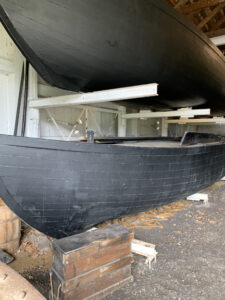
The ongoing event that is most associated in the public mind with the two parks is the annual recreation of the almost-mythical 1776 Delaware crossing organized by the Friends of Washington Crossing Park. It personifies the dramatic image of Washington standing in a boat on an icy river that has been ingrained in the American consciousness and become universally recognized, having been made the subject of countless paintings, sculptures, propaganda, and even present-day advertising.[6] This long-standing and widespread awareness of its historical salience has inspired various re-enactments of the crossing over the decades, including one staged by a Rider College fraternity in January 1947, and led to the annual Christmas Day ritual begun in December 1953 by a small crew in a half-scale Durham boat under the command of St. John Terrell, in the guise of George Washington.[7] That tradition continues to this day (weather and river conditions permitting), owing to a band of dedicated re-enactors who are organized independently of the two parks, and regularly draws several thousand spectators along both sides of the river and on the Washington Crossing Bridge. (The current steel bridge, which dates from 1905, replaced a covered wooden toll bridge swept away by a flood in 1903—successor to the original span that was built in 1834 and destroyed by a flood seven years later.)
The re-enactors who cross during this event embark from the Pennsylvania side, where the replica boats are moored, and begin their journey after assembling in formation on the riverbank under the watchful eye of a fellow Revolutionary enthusiast posing as General Washington, who delivers a motivational message to the gathering. More recently, a second annual re-enactment was added by WCHP on the second Sunday in December; and it follows the same protocol as the December 25 observance, although the latter differs from the one held earlier in the month in that it is open to the public without charge and is not accompanied by the more elaborate historical-educational programming that attends the other event.
The Parks’ Past
The two states initiated their respective efforts to memorialize the Christmas night 1776 crossing at different times and independently of each other. (Federal legislation was introduced as early as 1901 to establish a national military park at this site but not reported from committee in either the House of Representatives or the Senate.) New Jersey took the lead when it enacted legislation to create a series of commissions that began planning for a park and then acquired the original acreage that would constitute WCSP in 1912. Pennsylvania, which followed suit in 1917 when it statutorily created its own commission and began purchasing land for its venue, was the first to dedicate a park, on October 1, 1921. New Jersey did so on June 4, 1927. Along the way, various patriotic and historical organizations played important roles in creating the parks and providing memorials on both sides of the river.
A prominent Philadelphia physician, Isidor P. Strittmatter, became an unsung hero in the development of both WCHP and WCSP by acquiring more than three hundred acres of historically significant property on both sides of the river between 1901 and 1919 and then selling these parcels of land to each state for the purposes of their respective parks. While the New Jersey site has expanded far beyond Dr. Strittmatter’s holdings, on the Pennsylvania side these tracts would comprise most of the land within WCHP’s lower park—known as the McConkey’s Ferry section—where Washington’s soldiers embarked on their most famous river crossing.[8]
The Department of Conservation and Development, which assumed management of the New Jersey Park in 1915, became the Department of Environmental Protection in 1970. On the Pennsylvania side, the Washington Crossing Park Commission—initially responsible for the park’s management—was absorbed into the Department of Forests and Waters in 1923, then transferred to the Pennsylvania Historical and Museum Commission (PHMC) in 1971, and ultimately abolished by legislative action in 1998. In 2016, the Department of Conservation and Natural Resources replaced PHMC as the agency with managerial responsibility for the park.
On the Pennsylvania Side
The Visitor Center and Historic Village
The park’s Visitor Center is located in WCHP’s lower park. Originally known as the Memorial Building, it opened in 1959, then underwent various structural enhancements at the time of the Bicentennial, and was further expanded and renovated over a two-year interval when the building was closed to the public, from November 2009 to March 2013. It offers visitors an exhibit gallery, auditorium, and gift shop, with an orientation film and guided tours available to those interested.

Near the Visitor Center are the boat barn built in 1977 and a collection of historic buildings that are the remnants of the village of Taylorsville from the early nineteenth century. In 1777, Benjamin Taylor acquired the land on the Pennsylvania side of the McConkey’s Ferry crossing from Samuel McConkey, including the McConkey’s Ferry Inn, and that side of the ferry crossing would become known as Taylor’s Ferry and then Taylorsville, the community’s official mailing address once a post office opened there in 1829. The Taylor family created a self-sufficient locality that featured a blacksmith shop, wheelwright shop, tailor, physician, general store, and post office. Two of Benjamin’s sons, Mahlon and Bernard, emerged as the village’s most prominent citizens, and the two large stone houses they erected are still in existence. Mahlon’s overlooks the river, across the road from where the Taylor’s Ferry Inn stood, and Bernard’s is now part of the restaurant known as the Washington Crossing Inn adjacent to the grounds of WCHP. The family’s influence declined in the late nineteenth century as its lands were sold off, and in 1919—after the park had been established by statute—the mailing address of this locale was changed to Washington Crossing.[9]
The village structures that remain include a successor to the original ferry inn, which was situated next to where the Washington Crossing Bridge now stands and built of wood before the Revolution. Only the basement kitchen with its beehive oven remains. The current stone structure—referred to as “McConkey’s Ferry Inn” today (a technically incorrect designation, having been built after Samuel McConkey owned the inn and ferry)—was constructed in several stages; its west side, farthest from the river, dates from around 1790 and includes the original basement. It is possible, if not probable, that Washington was inside the inn when he penned a dispatch to Col. John Cadwalader of the Philadelphia Associators, then stationed downriver in Bristol, Pennsylvania, late on Christmas day 1776 but before crossing the river. Writing from “McKonkey’s Ferry” on the “25th Decr 1776” at “Six oClock P.M.,” the Continental Army’s commander in chief advised Cadwalader, “I am determined, as the night is favorable, to cross the river and make the attack upon Trenton in the morning. If you can do nothing real, at least create as great a diversion as possible.”[10] A copy of that missive is displayed in the WCHP exhibit gallery.
Most of the other historic village buildings—largely private residences in their day—are not generally open to the public, except for certain limited occasions. They include the following:
- the Mahlon Taylor House, located near the Washington Crossing Bridge and across the road from today’s “McConkey’s Ferry Inn,” a stately home built around 1817 that reflects Taylor’s successful career as a merchant and entrepreneur;
- a cluster of nineteenth-century structures that served different members of the Taylor family as their own residences;
- the 1828 Hibbs House, one of several tenant houses constructed by the Taylor family to attract artisans to Taylorsville, which variously served as the home and workshop of a shoemaker, cooper, wheelwright, and finally a carpenter named Abdon Hibbs;
- the Frye House, also built in 1828 as a tenant property, which housed Taylorsville’s blacksmith and his family and apprentice.[11]
The Enduring Durhams
The replica Durham boats housed in the boat barn at WCHP are believed to be reasonably accurate reproductions of the original Durhams that plied the Delaware and Lehigh rivers in the eighteenth century. An undetermined number were used to transport Washington’s infantry across the Delaware on Christmas night 1776, although a reasonable guess would be about sixteen.[12] The sturdy Durhams accomplished what Washington envisioned when he ordered that they be rounded up for the army’s use. In fact, one might speculate that those boats kept the Revolution afloat (in a manner of speaking) during its darkest days. The seaworthy—or river-worthy, to be precise—replica craft at WCHP are used in the re-enactment of that nautical enterprise undertaken twice each December.
The Durhams in the WCHP boat barn will soon have company, as the Friends group has arranged with Independence Seaport Museum in Philadelphia to fashion a new full-scale, forty-foot replica boat with funding provided by a generous array of foundations and individuals. When completed, it is anticipated that this vessel will be installed at WCHP as part of a new interpretive trail planned by the Department of Conservation and Natural Resources and serve as a centerpiece of expanded interpretive offerings by the park. Unlike with the current boats, visitors will have the opportunity to climb aboard the newest replica and benefit from a hands-on experience designed to afford them enhanced insight into the perspective of the men who rode—and rowed—these craft across a turbulent waterway on Christmas night 1776.
Lots of Leutze (pronounced “Loit-seh”)
Washington Crossing the Delaware (1851) by Emanuel Gottlieb Leutze (1816-1868) is probably America’s best-known historical painting and one of the most renowned works of art in history. Indeed, one might say that in the public’s mind, Leutze’s creation and the event that inspired it are inseparable.[13] Today, a visitor to WCHP can view a digital reproduction of the original oeuvre (about twelve by twenty feet) hanging above the stage in the Visitor Center auditorium, along with a story board that explains the history of the painting.

The Metropolitan Museum of Art in Manhattan (the Met), which has owned the original since 1897, loaned it out to WCHP from 1952 to 1970. Leutze’s image was displayed first in the local Methodist Episcopal Church and after the summer of 1959 in the park’s new Memorial Building. By one estimate, two hundred and fifty thousand people visited every year for a decade to eye the artist’s handiwork. In 1969, the Met formally recalled its loan of the painting to the park and brought it back for the Bicentennial in order to grace the museum’s American Wing. (The regal canvas and its imposing frame reside there still, at 1000 Fifth Avenue, inside Central Park, opposite 83rd Street.)
Since the original painting left WCHP, it has been replaced by a series of reproductions—the first time the Met ever granted permission for a copy to be made of a painting in its collection. These have included: a 1970 oil painting by Robert Williams commissioned by Ann Hawkes Hutton, founder and chair of the Washington Crossing Foundation’s board of directors and author of a book about Leutze and his achievement; a 1998 digital copy of the original painting produced by Muralite Murals of St. Paul, Minnesota; and a new 2013 digital copy created by Forbes Associates of Edgely, Pennsylvania, from a digital image owned by the Met.
Although Leutze’s painting is undoubtedly the most prominent and arguably the least accurate depiction of the Christmas night 1776 Delaware River crossing, it brilliantly captures the sense of fierce urgency that informed a difficult and hazardous undertaking. One might plausibly contend that this image of the crossing has resonated with generations of viewers worldwide in a way that no other has because Leutze’s work, better than any other, conveys the emotions that infused the rebel soldiers and their commander in chief at a perilous moment in the quest for American independence, on a night when Washington decided to roll the dice on a last-ditch gamble to save his army and perhaps the Revolutionary enterprise.
And if one wants to see a three-dimensional representation of Leutze’s opus, it stands by the Washington Crossing Inn, separated from the park by a narrow roadway. As indicated by an inscription on its northern side, this limestone statue was given as a Bicentennial gift to the “People of the United States” by the citizens of Bedford, Indiana, and the Indiana limestone Industry, dedicated on July 5, 1976. The statue was placed on the inn’s property—on ground leased by the Washington Crossing Foundation (which maintains the monument)—rather than in the park, in deference to the donors’ wish that it be located on a privately owned site associated with a nonpolitical entity.[14] And more recently, a bas-relief sculpture of Leutze’s painting—modeled after the one displayed outside the Museum of the American Revolution in Philadelphia—was installed in the Visitor Center as a tactile exhibition to accommodate the needs of blind and visually impaired persons for a touch tour that provides a more intimate appreciation of this iconic artwork.
In WCHP’s Upper Park: A Farmstead That Served Washington’s Army and More

The Thompson-Neely house and farmstead (TN) in Solebury Township—two miles south of New Hope (Coryell’s Ferry in 1776) and four miles north of the Visitor Center in WCHP’s lower park—are the primary historical focus of an excursion to the upper park. The house is the only building located within WCHP’s current boundaries to function as a headquarters for several of Washington’s officers prior to the Christmas night crossing.[15] They may very well have included Capt. William Washington (a distant cousin of George) and Lt. James Monroe (the fifth President of the United States, then eighteen-years-old), serving with Col. George Weedon’s 3rd Virginia Continental Regiment in a brigade commanded by Brig. Gen. William Alexander, known as Lord Stirling, which was encamped at TN.[16] On December 25, 1776, the men of Stirling’s brigade who were physically able to do so slogged four miles south from the grounds on and near the Thompson-Neely property to McConkey’s Ferry—in today’s lower park—to participate in the crossing and march to Trenton. In his diary entry for that day, one of them, Lt. James McMichael of Miles’s Pennsylvania Rifle Regiment, wrote, “We have now received the glad news that marching orders have been issued. At sundown, we marched down the Delaware to McConkey’s Ferry [in] weather uncommonly inclement.”[17]
Across the road from TN is an 1875 grist mill (the replacement for a structure destroyed by fire two years before) that, like the house, is open to the public for guided tours at specified times. Those interested can register online through the WCHP website for either or both of these tours but must do so at least a day in advance to ensure a historical interpreter will be on-site then. Nearby, the Bowman’s Hill Tower—built between 1929 and 1931—sits atop a hill that may have been used by rebel scouts in the winter of 1776-1777 to monitor the river and adjacent areas. On a clear day, the visitor who ascends its 125 steps to the top (by foot or elevator, although the operational status of the latter is often conjectural) can see some fourteen miles in any direction, extending over seven counties in two states.[18] The tower is open daily, and tickets for a self-guided tour can be purchased online or in person at the unpretentious shed by its entrance. Located at the base of this hillside is the Bowman’s Hill Wildflower Preserve, which comprises a significant portion of the upper park’s terrain (134 acres to be exact) but is operated separately from WCHP. Founded in 1934, it is the only accredited botanical museum in the country dedicated to native plants and receives no state funding, relying entirely on the generosity of its members and donors.[19]
The upper park at WCHP also features a memorial cemetery, a short distance from TN and situated between the Delaware Canal and the river. There a row of modern headstones marks the spot where the remains of an unknown number of Continental soldiers repose in a spacious, bucolic setting. Only one of the headstones bears a name: Capt. Lt. James Moore of the New York State Company of Artillery, who died in the Thompson-Neely house on December 25, 1776 at the age of twenty-four from “camp fever” (probably typhus).[20] The original headstone is now part of WCHP’s museum collection. Moore’s superior, Capt. Alexander Hamilton, described him as “a promising officer … who did credit to the State he belonged to.”[21] The other headstones in the cemetery refer simply to “unknown” soldiers, who like Moore succumbed to exposure, disease, and wounds during the winter encampment of 1776-1777 and may very well have spent their final days at TN. As written elsewhere, “the soldiers who lie by the Delaware are well attended on a site graced by the river’s flow and nature’s verdant canopy. The curious or reverent gaze of generations of visitors and a venerable park’s continuing ministrations have borne lasting witness to the collective sacrifice of these young men.”[22]
On the New Jersey Side
A Witness to the Crossing
Unlike the historic buildings in the lower park at WCHP, most of which date from the 1820s or 1830s, the Johnson Ferry House on the New Jersey side was there when the rebel forces stormed across the river (in more ways than one) on December 25-26, 1776. Built around 1740, it is the oldest and most historic structure within WCSP. Multiple accounts suggest that Washington may have warmed himself by its fireplace for some period of time after crossing the river.[23] Of course, the common soldiers under his command were afforded no such relief, however temporary it was, from the brutal weather that engulfed them that night, as reflected in the comments of a sixteen-year-old Massachusetts fifer, John Greenwood. Together with his comrades, he pulled down fences to make fires that provided only a modicum of warmth. “It rained, hailed, snowed, and froze, and at the same time blew a perfect hurricane,” Greenwood recalled, “so much so that I perfectly recollect, after putting the rails on to burn, the wind and the fire would cut them in two in a moment, and when I turned my face towards the fire my back would be freezing.”[24]
Imaginative Sights and Sounds
A new visitor center and museum are rising at WCSP and expected to open in time for the annual reenactments of the Delaware River crossing that will occur in December 2026 to mark the semiquincentennial of American independence (with the old center, which opened in 1976, slated for demolition). The new structure with its green roof will be much closer to the river’s edge than the current one—offering a sweeping view of the site where the 1776 crossing occurred—and in close proximity to the Johnson Ferry House. Inside, visitors will be greeted by a new, expanded exhibit designed to immerse them in the “Ten Crucial Days” campaign, including “The Crossing Experience” that presents an interactive recreation of the sights and sounds associated with crossing the Delaware to New Jersey on that fateful night aboard a reproduction ferry boat.
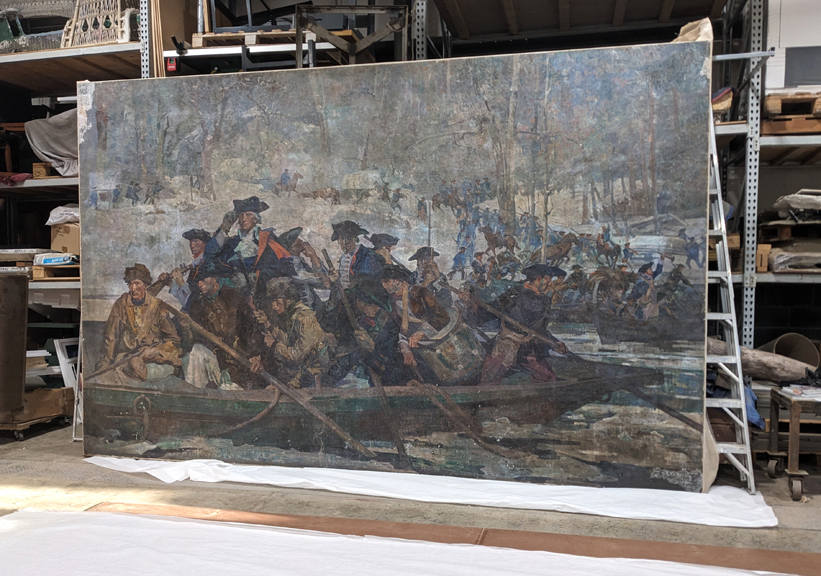
Finally, the lobby will showcase a terrazzo map of the river, as well as a significant original work of historical art, publicly displayed for the first time in more than a half-century: a priceless, recently restored mural (approximately fifteen and a half by ten feet) that depicts Washington and his troops crossing the Delaware. Having languished in a dusty basement for fifty years, it was unearthed and restored by the Washington Crossing Park Association. The creator, George Matthews Harding (1882–1959)—an American muralist and combat artist engaged in that capacity in both world wars—painted this mural in 1921 for Trenton’s Taylor Opera House, where it hung until the building was razed in 1969. At that time, the mural was coated with homemade wheat paste and Japanese rice paper, and rolled onto a custom-made cylinder with a view to restoring it for the new WCSP visitor center then slated for completion by the Bicentennial. Transported to Ringwood Manor State Park in North Jersey, the cylinder was placed in storage in a basement there; however, the interior confines of WCSP proved too small for this piece, and it remained essentially forgotten for the next five decades. The park association took on the mission of determining if the mural could be restored for the new museum by 2026 and, with the approval of the Department of Environmental Protection, hired Christyl Cusworth of Cusworth Conservation in Lambertville, New Jersey, to restore and frame the piece, then launched a fundraising campaign to support this effort with the help of large donations from Americana Corner, NJM Insurance, and private funders, as well as many smaller contributions from members and friends. The result should make for an arresting centerpiece in the new edifice that will overlook the river’s east bank.
A Founding-Focused Foundation
One cannot truly understand the historical-educational aspect of the New Jersey park without appreciating the role played by the Swan Historical Foundation (SHF), which has partnered with WCSP in fulfillment of the foundation’s mission to encourage and inspire continuing knowledge and appreciation of the Revolution for the benefit of present and future generations. SHF is named for an early member of the U.S. House of Representatives, Dr. Samuel Swan of Somerville, New Jersey, who sponsored legislation that provided a pension for the widows and orphans of the first American soldiers and led to the creation of the federal Veterans Administration. His great, great grandson, H. Kels Swan—a lifelong resident of South Bound Brook, New Jersey, a Rutgers University alumnus, and an author who served as historian and curator at WCSP—founded SHF in 1989 and became its president.
SHF is working closely with the State of New Jersey to build the new visitor center and museum at WCSP. Most of the artifacts in the SHF collection of 1,200 original items from the 1750-1810 era, which are currently displayed in the old center, have been on loan to WCSP for a number of years. A modernized iteration of this imposing exhibit will greet visitors to the state-of-the-art facility. (Additional items in the collection are currently on loan to other institutions or in storage.)
In addition to the care, interpretation, and expansion of its breathtaking collection, SHF has pursued other activities to promote public knowledge about the Revolutionary history attached to this river bank. In 2002, it commissioned artwork by a noted local artist, Loyd Garrison, which may be as accurate an image as we have of Washington’s Christmas night 1776 crossing by ferry boat. More recently, SHF participated in a thirteen-minute video, Crossing To Victory: Washington Recaptures New Jersey—made possible by a joint effort of the Mercer County Cultural and Heritage Commission, New Jersey Historical Commission, Mercer County Board of County Commissioners, NJM Insurance Group, and several generous individuals. The film examines some of the lesser-known events and sites at WCSP so critical to the success of the fabled crossing, subsequent march to Trenton, and victory over the Hessian garrison.
Putting Things in Perspective
In conjunction with its board of trustees, executive director Jennifer Martin leads the efforts of the Friends of Washington Crossing Park to educate the public about the significance of the location they oversee on the Delaware’s west bank and to preserve its legacy for future generations. Since 2010, the Friends have collaborated with the State of Pennsylvania to share the electrifying story of an extraordinary event: first, with the Pennsylvania Historical and Museum Commission, and since 2015 with the Department of Conservation and Natural Resources, as their associate in that endeavor. This arrangement parallels the ongoing partnership between the Washington Crossing Park Association and the New Jersey Department of Environmental Protection across the way. The manner in which Jennifer describes her personal motivation behind this work underscores the importance of instilling public enthusiasm for venues such as the two Washington Crossing parks and the history and heritage attached to them. For her, making the past come alive means making it both engaging and illuminating: “I like finding creative ways to make history fun for visitors of all ages so that people can connect with and understand the importance of preserving places like Washington Crossing Historic Park and sharing the important history that took place here.”[25] And Annette Earling, executive director of the Washington Crossing Park Association, amplifies these sentiments: “Both parks work to pass on the stories that made the 1776 crossing a success—not just the famous names, but the people, cultures, and lifeways that contributed to the formation of America. It’s a huge honor.”[26]
One discerns in these comments a message of particular value for younger generations who will assume the stewardship of these venerable grounds. John Adams memorably opined that “the Revolution was in the minds and hearts of the people.”[27] And while his observation may have been true then, today’s task of cultivating and sustaining a widespread public interest in that struggle and its ramifications poses a steep challenge for the keepers of history’s flame—even at Washington Crossing, notwithstanding its cachet as a hallowed launching pad for perhaps the ten most remarkable days in American history.
For More Information:
Washington Crossing Historic Park (PA) — washingtoncrossingpark.org
Washington Crossing State Park (NJ) — nj.gov/dep/parksandforests/parks/washingtoncrossingstatepark.html
Washington Crossing Park Association of New Jersey — wcpa-nj.com
The author gratefully acknowledges the assistance of the following individuals in preparing this article: Jennifer Martin, Executive Director, Friends of Washington Crossing Park; Annette Earling, Executive Director, Washington Crossing Park Association; and Richard J. Kane, Chairman, Swan Historical Foundation, Inc.
[1] James Wilkinson, Memoirs of My Own Times (Abraham Small, 1816. Reprint: Sagwan Press, 2015), 1:128.
[2] Nathanael Greene to Catharine Greene, December 16, 1776, in The Papers of General Nathanael Greene, ed. Richard K. Showman (The University of North Carolina Press, 1976), 1:368.
[3] Ambrose Serle, Journal, December 27, 1776, in The American Journal of Ambrose Serle, Secretary to Lord Howe, 1776-1778, ed. Edward H. Tatum, Jr. (The Huntington Library, 1940. Reprint: Arno Press, Inc., 1969), 163.
[4] George Trevelyan, The American Revolution (Longmans, Green, and Co., 1903), part 2, 2:122-123.
[5] Remarks by George Germain, May 3, 1779, in The Parliamentary Register: Or History of the Proceedings and Debates of the House of Commons during the Fifth Session of the Fourteenth Parliament of Great Britain (John Stockdale, 1802), 11:392.
[6] Robert W. Sands, Jr., and Patricia E. Millen, Images of America: Washington Crossing (Arcadia Publishing, 2022), 7.
[7] Peter Osborne, No Spot in this Far Land is More Immortalized: A History of Pennsylvania’s Washington Crossing Historic Park (Yardley Press, 2014), 351-353.
[8] Ibid., 129-145.
[9] Ibid., 39-42.
[10] George Washington to John Cadwalader, December 25, 1776. Founders Online, National Archives, founders.archives.gov/documents/Washington/03-07-02-0343.
[11] “The Historic Village,” Washington Crossing Historic Park, www.washingtoncrossingpark.org/park/the-village-lower-park/.
[12] Nathanael Greene to James Ewing, December 19, 1776, in The Papers of General Nathanael Greene, ed. Roger N. Parks (The University of North Carolina Press, 2005), 13:712. Writing from Bougart’s Tavern in Buckingham, Pennsylvania, Greene advised Brigadier General Ewing that Washington “desire[s] you to send down to McConkey’s Ferry, sixteen Durham Boats & four flats [ferry boats] … as soon as possible.” Although this suggests the number of boats planned for the Christmas night crossing, it is unknown whether the sixteen were actually sent and whether the ferry boats used that night were already on the scene or part of the four mentioned. See William M. Welsch, “Christmas Night 1776: How Did They Cross?” Journal of the American Revolution, December 24, 2020, allthingsliberty.com/2013/10/christmas-night-1776-cross/.
[13] Anne Hawkes Hutton, Portrait of Patriotism: “Washington Crossing the Delaware” (Chilton Company – Book Division, 1959), 147.
[14] Osborne, No Spot in this Far Land is More Immortalized, 410.
[15] Ibid., 71.
[16] William W.H. Davis, History of Bucks County, Pennsylvania: From the Discovery of the Delaware to the Present Time (The Lewis Publishing Company, 1905), 2:121.
[17] William P. McMichael, “Diary of Lieutenant James McMichael of the Pennsylvania Line, 1776-1778,” The Pennsylvania Magazine of History and Biography 16, no. 2 (1892): 140.
[18] Osborne, No Spot in this Far Land is More Immortalized, 213.
[19] “People of the Preserve,” Bowman’s Hill Wildflower Preserve, bhwp.org/people/our-story/our-mission/.
[20] Davis, History of Bucks County, Pennsylvania, 2:121.
[21] Alexander Hamilton to the Provincial Congress, March 6, 1777, in The Works of Alexander Hamilton, ed. Henry Cabot Lodge (Federal Edition) (G.P. Putnam’s Sons, 1904), 9:44.
[22] David Price, “When War Came to the Thompson-Neely Farmstead.” Journal of the American Revolution, June 24, 2021, allthingsliberty.com/2021/06/when-war-came-to-the-thompson-neely-farmstead/.
[23] Mark Maloy, Victory or Death: The Battles of Trenton and Princeton, December 25, 1776-January 3, 1777 (Savas Beatie, 2018), 45; Sands and Millen, Images of America: Washington Crossing, 56; Osborne, No Spot in this Far Land is More Immortalized, 99.
[24] John Greenwood, The Revolutionary Services of John Greenwood of Boston and New York, 1775-1783, ed. Isaac John Greenwood (The De Vinne Press, 1922), 39.
[25] David Price, “Keeping History Alive in Challenging Times.” dpauthor.com blog post no. 15, February 2, 2021, dpauthor.com/speaking-of-which/.
[26] Annette Earling, email to author, June 26, 2025.
[27] John Adams to Hezekiah Niles, February 13, 1818, Founders Online, National Archives, founders.archives.gov/documents/Adams/99-02-02-6854.
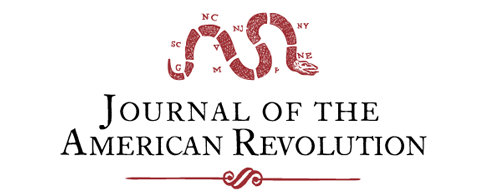

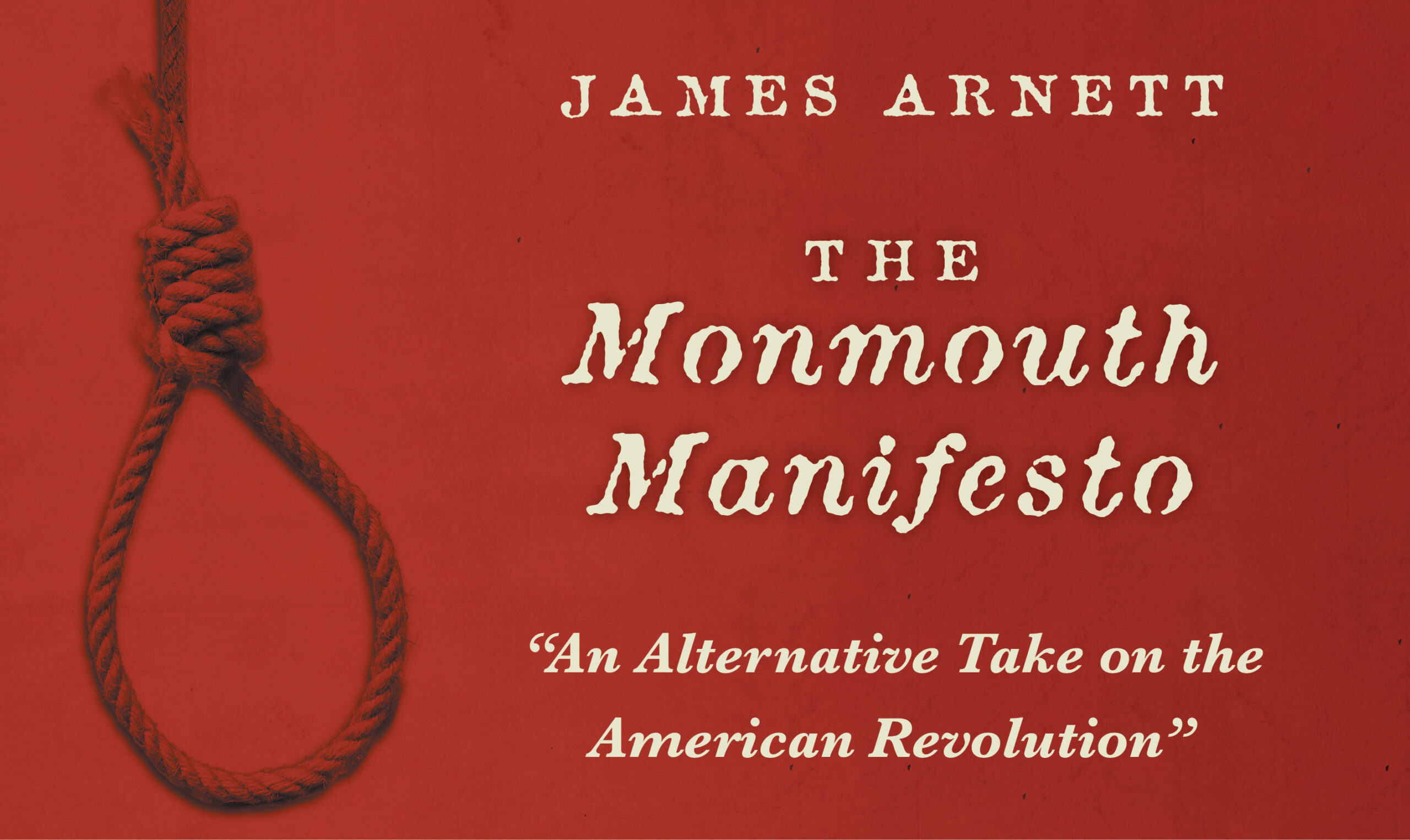
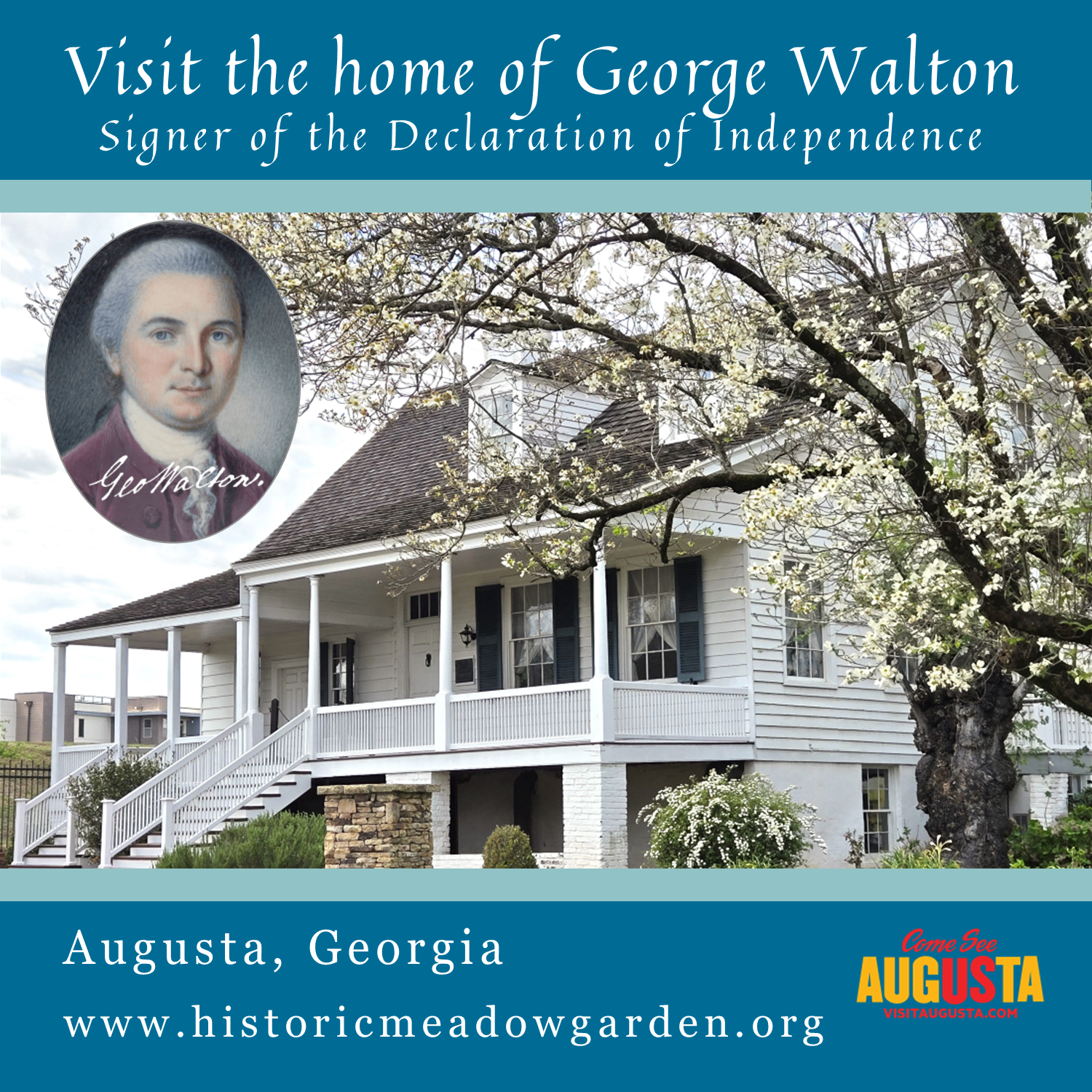


Recent Articles
Washington Crossing: A Tale of Two Parks
The Wrong Remedy
Fighting for Philadelphia
Recent Comments
"Ruling Rebels: How the..."
"Stamps" to be affixed to documents were NOT sent to the colonies,...
"Unraveling the Mystery of..."
Great article! Well written and well researched. Thank you!
"Unraveling the Mystery of..."
Thank you Mr. Gardiner for evaluating and reporting this information you have...